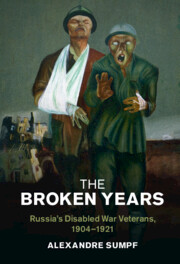Book contents
- The Broken Years
- Studies in the Social and Cultural History of Modern Warfare
- The Broken Years
- Copyright page
- Contents
- Figures
- Tables
- Acknowledgements
- Note on Usage
- Introduction
- 1 An Overwhelming Loss
- 2 The Right to Health
- 3 A Social Status Renegotiated by the War
- 4 Discriminatory Social Welfare
- 5 An Ephemeral Political Spring
- 6 The Devaluation of the War Experience
- Conclusion
- Bibliography
- Index
Introduction
Published online by Cambridge University Press: 10 February 2022
- The Broken Years
- Studies in the Social and Cultural History of Modern Warfare
- The Broken Years
- Copyright page
- Contents
- Figures
- Tables
- Acknowledgements
- Note on Usage
- Introduction
- 1 An Overwhelming Loss
- 2 The Right to Health
- 3 A Social Status Renegotiated by the War
- 4 Discriminatory Social Welfare
- 5 An Ephemeral Political Spring
- 6 The Devaluation of the War Experience
- Conclusion
- Bibliography
- Index
Summary
In 1916, certain film-goers in Russia’s big cities had the privilege of watching dozens of amputees and maimed men hustle and bustle on the screen for almost an hour.1 We know nothing about these anonymous figures, who represented both victims of war and a narrative of resurrection. We know nothing and no one saw anything but these shots of them as they are getting treated, examined, fitted with prosthetic devices, and professionally retrained. Reborn to Life was certainly a silent movie, as were all the films of the time, but what is most significant in this case is that it did not let these veterans speak: we can only attentively follow their attitudes, gestures, and looks, then guess at their thoughts and emotions. The disabled veterans were objectified: they merely stood as a symbol of the war’s cruelty; these were victims, the living dead far more conspicuous than the millions of corpses buried at the western margins of the empire.
- Type
- Chapter
- Information
- The Broken YearsRussia's Disabled War Veterans, 1904–1921, pp. 1 - 16Publisher: Cambridge University PressPrint publication year: 2022

